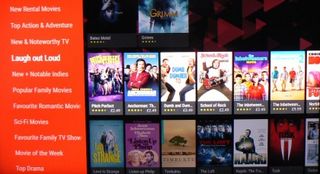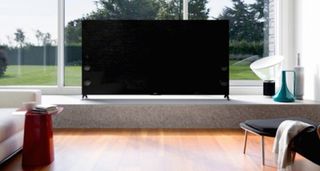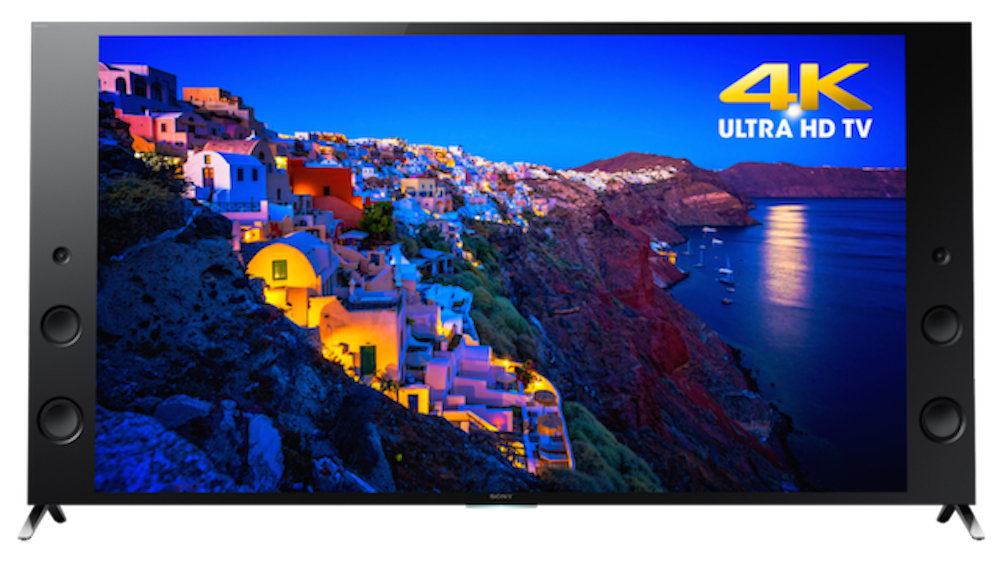TechRadar Verdict
Aside from its headline Android TV smart platform failing to convince me that it's the future of smart television, the 75X9405C is an unmitigated success. Its picture quality is even better than anything Sony managed to produce with the highlight models from its 2014 4K TV range, and its incredibly powerful and dynamic audio is literally music to your ears.
Pros
- +
Sensational picture quality
- +
Equally sensational sound quality
- +
Content-rich smart platform
- +
Excellent auto picture optimisation
Cons
- -
Space-consuming chassis design
- -
Android doesn't convince
- -
Upscaling can cause noise
- -
Slight light blooming issues
Why you can trust TechRadar
If there's one thing the Sony 75X9405C is not, it's shy.
For as well as having the chutzpah to stick a 75-inch screen in your living (or, more likely, home cinema) room, it has the cojones to surround that mammoth screen with a good many more inches of speaker-bearing frame.
To be fair, it doesn't do any of this unattractively. On the contrary, the gorgeous glassy finish that lies over both the screen and its frame looks and feels beautifully premium - once you've wiped your fingerprints off it - and the way the TV's six front-facing speakers seem to be etched out of the glass is glorious.
Yes, I did say six speakers back there.
For in what's now a trademark of Sony's top-end TVs, the 75X9405C partners its big pictures with an equally big sound. Each side of the screen carries two main drivers and one treble tweeter, with the main speakers both enjoying Sony's magnetic fluid technology to deliver a richer, larger sound without needing the sort of physical space you'd normally require for a powerful speaker.
Bulk excuse
Even with the magnetic fluid tech the 75X9405C's rear sticks out more than most, giving the set a distinctive wedge-shaped side profile.
But I personally have no problem with this at all if it leads to brilliant sound quality. And I'm pretty confident it WILL lead to brilliant sound given that the 75X9405C is the first TV rated as good enough to play high resolution audio files.
The 75X9405C's connections are up to speed with their highlights of four HDMIs, Wi-Fi and LAN network connections, and USBs for playing back multimedia files or recording from the TV's Freeview and Freesat tuners to USB storage drives.
The network connections support streaming from networked computers, tablets and smartphones, with Bluetooth and NFC also available if you want a more direct connection.
At which point I need to introduce Android TV.
The 75X9405C is the first TV I've tested that carries the fruit of Google's latest stab at crossing over into the TV world after a couple of abortive previous attempts, and it sits on Sony's set alongside integrated YouView functionality and Sony's own Discover system.
Or at least it will sit alongside YouView when the latter service is added via a firmware update later this year.

Google box
Hit the Home key on either of the 75X9405C's remote controls (you get a streamlined 'OneFlick' handset with an integrated touch pad alongside a more standard issue effort) and you're taken straight to the new Android screen.
This appears as a series of horizontal shelves, with recommended content at the top, featured apps below, links to all the TV's inputs below that, and then a general Apps shelf. This houses all the apps you've downloaded to the TV already, as well as the Google Store app from where you can hunt out and download more apps to the TV's built-in 16GB of app storage.
Android fans should note that the Android TV Google Store does not feature every app you can get for your tablets and smartphones. Which is actually a good thing given how unsuited many normal apps and games are to TV use.
Google has introduced a filtering system that only allows through to TVs apps that meet the necessary control and design criteria.
Don't worry, though; even after this filtering process there are more apps than you get with other Smart TV platforms, and the number will inevitably rise given the amount of app development constantly going on in the Android universe.
Less is more?
It did strike me, though, that there are pros and cons to this limitless app potential.
For while a few great apps may well turn up, there will also likely be a lot of dross to clutter the place up. Also, the relatively passive and, crucially, communal nature of TVs vs smartphones and tablets both seem to sit in opposition to the idea of trawling through hundreds of apps to find the odd gem.
And does anyone really want to do anything on a TV other than watch TV shows and films?
So is there really any need for many apps beyond those that provide portals to different kinds of TV-friendly content like Netflix, the BBC iPlayer, Amazon and so on?
To be fair the quality of some of the non-streaming apps - especially the games - is impressive.
Light years on from the sort of stuff we got when Smart TVs first appeared. But it constantly felt to me like your personal smart devices are a much more natural home for much of what Android TV delivers than your TV. Especially as at the moment, at least, the Android interface supports neither manual customisation or different home screens for different users.

YouView saves the day
It's also just as well that Sony is bringing YouView to the party, as bizarrely Android TV currently does not offer any of the BBC iPlayer, ITV Player, 4OD or Demand Five catch up TV apps.
I haven't been able to test YouView in its Sony TV home yet, but it will surely offer the same key features seen with standalone YouView devices.
Which is to say you'll be able to access catch up TV services for a number of Freeview channels, while also being able to track down shows you may have missed via YouView's inspired 'back EPG', where you can scroll backwards as well as forwards through the TV listings.
While Android TV might grab the smart TV headlines for the 75X9405C, I'm actually more of a fan of Sony's own Discover smart interface.
Again accessed via dedicated remote control buttons, the Discover interface comprises a series of layers that appear slickly superimposed over the bottom edge of the picture (versus the Android approach, which clumsily takes over the whole screen). Each layer you scroll down introduces shortcuts to different types of content, be it the digital TV tuners, recommended TV shows, YouTube videos, personalised favourite channel lists, or recommended TV shows based around up to 10 keywords you can manually input into the TV's memory banks.
Some customisation at last
There's even an apps shelf here where you can put your most used/preferred apps, to save you having to track them down from your longer Android app list.
In other words, the Discover system offers just the sort of slick, minimal presentation and simple customisation options that Android TV currently does not.
All this and I've barely touched yet on features connected to what is actually the heart of the 75X9405C's potential appeal: its picture quality.
Inevitably for a big, premium screen this year the 75X9405C features a native 4K resolution. But it also carries Sony's latest Triluminos technology for a richer, more dynamic colour palette; direct LED lighting with local dimming to boost contrast; and Sony's new X1 video processor.
The X1 allegedly introduces a plethora of improvements to picture quality such as improved noise reduction; even more accurate, subtle colour reproduction achieved by looking at each individual colour individually rather than only working on the colour content of an image on a macro level; more sophisticated automatic handling of different source types (including different types of 4K source); and apparently even more detailed, precise upscaling of non-4K sources than Sony has managed before.
The 75X9405C offers 3D playback too using the full-resolution active system, with two pairs of glasses included free.
And last but not least the 75X9405C will also, I'm assured, support the new high dynamic range (HDR) picture system following an update planned for later in the year. HDR, if you're not familiar with it, can deliver pictures containing a much wider luminance range than the pictures we've been watching on our TVs for decades now.
John has been writing about home entertainment technology for more than two decades - an especially impressive feat considering he still claims to only be 35 years old (yeah, right). In that time he’s reviewed hundreds if not thousands of TVs, projectors and speakers, and spent frankly far too long sitting by himself in a dark room.

